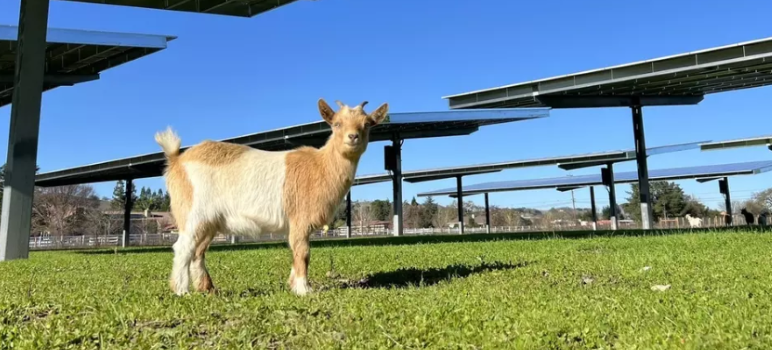The goats at the County of Santa Clara Animal Services Center have a new source of shade: an array of solar panels that generate power for the 37,000-square-foot shelter.
The county Facilities and Fleet Department completed the project last fall. It’s one of three solar arrays the department constructed in 2024, part of a larger campaign to expand solar power capacity and battery storage at County facilities.
The panels at the Animal Services Center are located in the pasture behind the facility, where the shelter maintains a herd of resident goats, which keep the weeds in check, and any horses or other large animals that are up for adoption. The center at 12425 Monterey Road in San Martin primarily serves Morgan Hill, Gilroy and unincorporated areas in south Santa Clara County.
Besides generating energy, the panels provide the animals with shade when it’s sunny and shelter when it rains.
“It gives the animals a choice, so they can decide where they’re more comfortable,” said Lisa Jenkins, manager of the state-of-the-art shelter. “That’s an important thing for animals in these vulnerable situations. It helps relieve their stress to be able to have some choice about how they’re living.”
The 627-kilowatt array is expected to produce nearly 1 million kilowatt-hours of energy in its first year of operation. Some of the energy produced by the panels goes to the shelter, while the rest flows into the power grid.
The panels also expand the shelter’s capacity to shelter large animals in the event of emergencies such as wildfires or earthquakes. The Animal Services Center, which typically keeps any livestock in a barn next to the pasture, now has the ability to set up temporary pens under the panels.
The Facilities and Fleet Department completed two other solar projects in 2024. One is located at Muriel M. Wright Residential Center, a substance-use recovery facility in South San Jose. Contractors installed two solar arrays on the property, which overlooks Coyote Valley from a hill in Santa Teresa County Park and includes a sheriff’s substation.
The other is situated at the Fleet Management building on Junction Avenue in San Jose. The project, completed over the summer, added six solar canopies to the property. The arrays will produce enough electricity to zero out the building’s electrical bills.where the shelter maintains a herd of resident goats, which keep the weeds in check, and any horses or other large animals that are up for adoption.
The improvements support the county’s sustainability strategy, which calls for the organization to be carbon neutral by 2030, and it advances the Board of Supervisors’ goal of “improving community resilience in the face of climate change.”
“The completion of these projects demonstrates our commitment to clean energy,” said Jeff Draper, director of the Facilities and Fleet Department. “Over the next 20 years, these projects and others will generate significant savings for the County while helping us achieve our goal of carbon neutrality.”
To become carbon neutral, the county must reduce its greenhouse gas emissions to the point where they can be matched by carbon offsets and sequestration.
The Board of Supervisors has made promoting sustainability one of its five policy priorities. This includes protecting natural resources and the environment, reducing climate pollution, improving resiliency, and pursuing climate equity.


feel good crumbles
yawl this desperate?
No information in this article about how much this project cost? You note it will save the county money, but what was the upfront outlay? How long will it take to recover that investment?
I guess that isn’t important when you are spending taxpayer (federal, state or local) dollars.